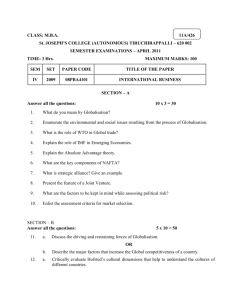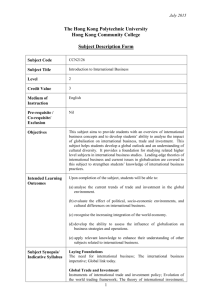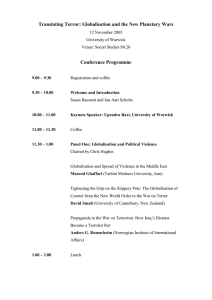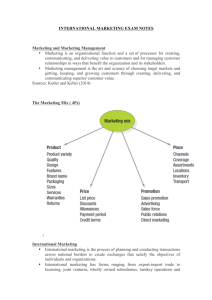Document 14249854
advertisement
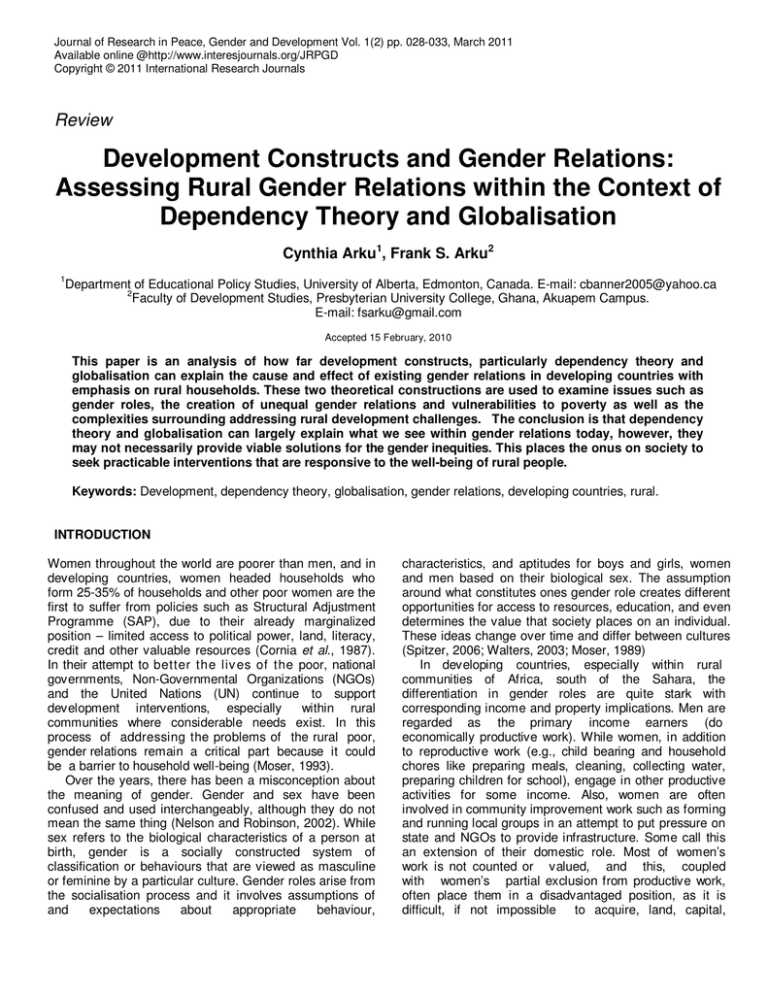
Journal of Research in Peace, Gender and Development Vol. 1(2) pp. 028-033, March 2011 Available online @http://www.interesjournals.org/JRPGD Copyright © 2011 International Research Journals Review Development Constructs and Gender Relations: Assessing Rural Gender Relations within the Context of Dependency Theory and Globalisation Cynthia Arku1, Frank S. Arku2 1 Department of Educational Policy Studies, University of Alberta, Edmonton, Canada. E-mail: cbanner2005@yahoo.ca 2 Faculty of Development Studies, Presbyterian University College, Ghana, Akuapem Campus. E-mail: fsarku@gmail.com Accepted 15 February, 2010 This paper is an analysis of how far development constructs, particularly dependency theory and globalisation can explain the cause and effect of existing gender relations in developing countries with emphasis on rural households. These two theoretical constructions are used to examine issues such as gender roles, the creation of unequal gender relations and vulnerabilities to poverty as well as the complexities surrounding addressing rural development challenges. The conclusion is that dependency theory and globalisation can largely explain what we see within gender relations today, however, they may not necessarily provide viable solutions for the gender inequities. This places the onus on society to seek practicable interventions that are responsive to the well-being of rural people. Keywords: Development, dependency theory, globalisation, gender relations, developing countries, rural. INTRODUCTION Women throughout the world are poorer than men, and in developing countries, women headed households who form 25-35% of households and other poor women are the first to suffer from policies such as Structural Adjustment Programme (SAP), due to their already marginalized position – limited access to political power, land, literacy, credit and other valuable resources (Cornia et al., 1987). In their attempt to better the liv es of the poor, national governments, Non-Governmental Organizations (NGOs) and the United Nations (UN) continue to support development interventions, especially within rural communities where considerable needs exist. In this process of addressing the problems of the rural poor, gender relations remain a critical part because it could be a barrier to household well-being (Moser, 1993). Over the years, there has been a misconception about the meaning of gender. Gender and sex have been confused and used interchangeably, although they do not mean the same thing (Nelson and Robinson, 2002). While sex refers to the biological characteristics of a person at birth, gender is a socially constructed system of classification or behaviours that are viewed as masculine or feminine by a particular culture. Gender roles arise from the socialisation process and it involves assumptions of and expectations about appropriate behaviour, characteristics, and aptitudes for boys and girls, women and men based on their biological sex. The assumption around what constitutes ones gender role creates different opportunities for access to resources, education, and even determines the value that society places on an individual. These ideas change over time and differ between cultures (Spitzer, 2006; Walters, 2003; Moser, 1989) In developing countries, especially within rural communities of Africa, south of the Sahara, the differentiation in gender roles are quite stark with corresponding income and property implications. Men are regarded as the primary income earners (do economically productive work). While women, in addition to reproductive work (e.g., child bearing and household chores like preparing meals, cleaning, collecting water, preparing children for school), engage in other productive activities for some income. Also, women are often involved in community improvement work such as forming and running local groups in an attempt to put pressure on state and NGOs to provide infrastructure. Some call this an extension of their domestic role. Most of women’s work is not counted or valued, and this, coupled with women’s partial exclusion from productive work, often place them in a disadvantaged position, as it is difficult, if not impossible to acquire, land, capital, Arku and Arku 029 and power. The situation is worse for women-headed households, where their partners are permanently absent because of separation, death or temporarily absent over a long term due to famine or wars (Moser, 1989). In contrast, the majority of men’s work is valued either directly through paid remuneration, or indirectly through status and political power, especially when they get involved in community development roles and become leaders. This creates an unequal relationship between men and women. To address this difference, feminist theorists call for strategic policy approaches that would eliminate the uneven relationship so that rural women do not remain marginalised. There have been extensive discussions around gender needs over the years. Various organizations including the United Nations(UN), governmental agencies and NGOs have been instrumental in establishing development interventions. Some of which have been in the form of providing basic needs like water, shelter, health and education. While some of the programs targeted both men and women, others are gender specific, such as equity and empowerment programmes (e.g., microfinance, skill training, and literacy programs) (Hashemi et al., 1996) with the aim to help the poor rural women to engage more in income generating activities. These could liberate women because they can have a fair share of the benefits of development and ultimately challenge the traditional roles of men (Arku and Arku, 2009). However, it has been observed in some cases that income-generating activities which are meant to liberate women have rather increased their working day (Moser, 1989). Following is a review of the two concepts: dependency theory and globalisation. From these theoretical positions, we will assess how they explain gender relations in rural households and their implications for rural development within the context of developing countries Dependency Theory and Gender Relations Dependency theorists are concerned with the causes of underdevelopment in developing countries, and generally attributed the ‘falling behind’ of the developing countries (initially, Latin America) to the dynamic and contradictory growth of the world capitalist system. Their notion is that underdevelopment or undervelopment resulted from the same world historical process by which advanced capitalist countries became developed. Thus, the development of Europe was based on external destructions: brutal conquest, colonial control, and the stripping of non-Western societies of their resources and surpluses (Martinussen, 1997). Hence, it is the dependency of developing countries on the developed countries that has created their ‘underdevelopment’, and has created underdevelopment in the developing countries, and development in the developed countries. Several strands of dependency theories can be identified and this paper primarily uses the Structuralists’ and Neo-Marxists’ views in examining gender relations. (i) Structuralists Unlike Keynes who considered unemployment as a conjunctural phenomenon, the Structuralists perceived unemployment as a consequence of structural conditions. For them, unemployment was a reflection of economic underdevelopment and thus, a problem that could be solved only through structural transformation. Based on this perception, they paid particular attention to the barriers that obstructed structural changes. In contrast with the growth and modernisation theories, which emphasised lack of capital as the major reason for economic stagnation, the structuralists were more interested in the underlying reasons for the lack of capital for financing industrialisation, which they regarded as the principal pathway to development (Hettne, 1995). One reason for the lack of investments in developing countries, according to the structuralists, was the subordination of the structure of their economies, which mainly produced primary goods for the industrial West, and prevented local industrialisation to thrive. The small size of their domestic markets for the modern sector coupled with the dependence on the developed countries for capital could not sustain the industrialisation process. Thus, this capital deficiency stands in the way when developing countries try to diversify from export of raw and semi-manufactured materials to more capital and technological–intensive goods in order to partake in the international market where the incentives are greatest (Martinussen, 1997). Also, the prices of manufactured goods from the industrialised countries remained high even during the period of economic stagnation because of the protectionist role labour movements that occurs in industrialised countries. This ‘capital low’ in developing countries along with high prices of goods from industrialized countries only worked to the disadvantage of the former. As analysed by Prebisch (1976) developing countries had to sell greater quantities of their products to acquire the same export revenue, characterized as unequal terms of exchange. Prebisch and other structuralists were careful to not discourage developing countries from industrializing to advance more benefits in trade. They were concerned that a delay in starting to industrialize would make it more difficult to do so over time, so the quicker the start the better. In addition, the structuralists recommend that as latecomers to the industrialisation process, developing countries should protect their domestic industries over the long transition period into an industrialized status Also, they encouraged developing countries to seek support in the form of foreign direct investments and international loans on 030 J. Res. Peace Gend. Dev. favourable terms from rich countries to help hasten the industrialisation process. By so doing, developing countries could be able to benefit from international trade and thereby lift themselves from an underdeveloped state to a developed state (Martinussen, 1997; Hoogvelt, 2001). (ii) Neo Marxists Neo-Marxists dependency theorists emerged from Marx’s later conceptions that imperialism has been destructive rather than constructive to the developing countries. Like the structuralists, Neo-Marxists dependency theorists objected the view that imperialism and its contemporary forms favour developing countries. Also, for them, underdevelopment is caused mainly by class relations and their impact on the utilisation of the economic surplus (Peet and Hartwick 1999). Some of these Neo-Marxists theorists include Paul Baran (1992, 1957), Andre Gunder Frank (1992, 1979, 1969ab) and Samir Amin. For the purpose of this paper, we focus on Baran’s and Frank’s work since they provide valuable explanations for unequal gender relations. Baran’s position is that land rent, interest on credit and profits from trade within peripheral countries were appropriated by the economically dominant class who had no real interest in promoting industrialisation and its accompanying transformation in the peripheral economies, since that will threaten their access to the traditional sources of economic surplus. The only way Baran could see the end to this exploitation was through extensive state intervention to promote nationallycontrolled industrialisation just like the structuralists proposed. Gunder Frank, on the other hand, was more interested in the exchange relations and network between the metropoles and satellites, through which surplus was appropriated by the centres to higher level centres abroad. Similarly, this relationship exists in the rural regions of the peripheral countries, which are linked to the urban regions, and through several links, until it reached the ruling classes and world centres of capitalism. According to Frank, developing countries would be better off if they de-link from the world market system. This is because satellites will be better off economically if they weaken their ties with their metropolis (Frank, 1992, 1979, 1969ab). However, this stance has faced a number of criticisms. For example, how can developing countries de-link when they constantly depend on the West for basic human needs such as food? (iii) Dependency theory and gender relations in rural societies that begs to be asked is this: why is it that women perform two-thirds of the worlds working hours yet own only one-hundredth of the world’s property? (Peet and Hartwick,1999). Interestingly, gender relations can be literally reduced to a trade scenario within the household; a dependent relationship where men principally engage in productive work, and trade their goods and services with the reproductive ones that women do. What makes the trade unequal is the value of the products that they exchange. While services that women trade are considered ‘primary with little or no value’, men’s wares which include sale of livestock attract ‘greater value’. It is also unfavourable because some of the women’s work does not yield tangible, tradable products. Thus, women are incapable of earning incomes commensurate with their long working hours! The little that women gain from this trade often is re-used to purchase food, clothing and other needs for the household. Consequently, men who get greater value for their wares are in a better position to purchase land, capital and consequently earn rent, interests, and profits - a reflection of Baran’s view. The Structuralists may attribute this skewed state of affairs to the unequal relationship, thereby necessitating fast ‘industrialisation’ of the nation, in this case, of women. So, what does it mean for women to industrialize and what are the implications? More and more women are attaining higher education, have become active participants in the new labour market – such as in business and public management. Many women have truly industrialized! The popular saying among Africans that behind every successful man is a woman depicts the core- periphery dependent relationship that Baran noted. The development of the core (men) depends on the periphery (women) and the development of men (core) has caused the underdevelopment of women (periphery). Also, the fact that men who are often in leadership roles have little or no political will to promote gender equality agenda (see Moser, 1993) is an indication that men view women’s ‘development’ as a threat to theirs. This corresponds to Baran’s view that core (men) has no intention to develop the periphery (woman) because of the related threat to gains. Arku’s and Arku’s (2009) study of the effects of micro-finance on household relations shows how women’s empowerment through income generating work, may not necessarily bring about their ‘empowerment over men’ as husbands are more likely to co-operate in household decision-making when their wives are economically active than when they are not. Unlike Baran and structuralists, for Frank the best solution to the unequal exchange relationship between men and women will be for women to de-link from men. Could Frank’s suggestion be extended to imply ‘divorce/separation’ is the solution? The problems associated with single parenting and its impacts on child rearing are far reaching (Lamb and Kelly, 2001) and Arku and Arku 031 need not to be worsened. Mitchell (1966) in Peet, (1999: 167) noted that women “activities fulfilled the function of the maintenance and activities fulfilled the function of the maintenance and reproduction of labour power in relation to production”. Thus, women’s reproductive work supports the productive work of men. This can mean that traditional gender roles perhaps need to remain so, so that women would continue to operate in their reproductive capacities to enable men to work and support the production process on the assumption that some of the incomes that men earn contribute to the upkeep of women and their children. Also, women could be remunerated directly and formally in wages for their contribution to supporting in the workforce and maintaining the household. The forgoing shows that dependency theories c a n explain the causes of inequality among women and men. Nonetheless, it provides limited solutions in tackling the complexities of gender relations. Educational campaigns to create awareness of the plight of women and to appeal to the cultures and institutions to become flexible enough in allowing changes and discriminatory policies such as those that ensure equal wages for both women and men, as well as better maternity benefits for mothers are all essential to social justice for women. Globalisation and gender relations While some view globalisation as a recent phenomenon, others see it as having a historic trajectory. Shiva (1997) advances three historical waves of globalisation: European colonialism, the imposition of western development, and the current era of free trade. Others argue that what actually opened the door to globalisation were the economic crisis and recession of 1973 and 1979 and environmental regulations and other restrictions on company activities that appeared more and more in industrial countries throughout the 1980s and early 1990s. This new ideology of globalisation was then considered an all inclusive strategy because it contained the answer to all problems (Saul, 2004). What people mean by ‘globalisation’ is often confusing. Scholte (2000) has, for instance, argued that there are several definitions of globalisation. According to Scholte, globalisation can mean ‘internationalisation’, implying cross-border relationships between countries to facilitate international exchange and interdependence. Globalisation to him could also be referred to as ‘westernisation’ or ‘modernisation’ implying spread of modernity (capitalism, rationalism, industrialism, bureaucratism) over the world, where pre-existent cultures are destroyed. Scholte maintains that the definition that offers clear and specific understanding is globalisation as ‘deterriotorialisation’, which entails ‘reconfiguration’ of geography, so that social space is no longer mapped in terms of territorial borders. Giddens (1990) added that globalisation involves intensification of world-wide social relations that link distant localities in such a way that local happenings are shaped by events happening many kilometres away and vice versa. The fundamental premise of globalisation is that an increasing degree of integration among societies plays a crucial role in social and economic changes. Thus, through the process of globalisation, wealth is spread to all parts of the world by creating productive employment, increasing productivity and higher incomes for all, especially the world poor. Martinussen (1997) identified three fundamental changes that led to the global shifts to production and new patterns of industrial growth during the 1970s in developing countries. First is the increasing cheap labour in the developing countries due to modernisation, and increased productivity of agriculture in many countries, which had further increased the number of unemployed by pushing many farmers out of production. Second is the technical possibilities which allowed fragmentation of the production process into many parts such that an unskilled or quickly trained workforce could typically carry out several activities. Third is the development of an inexpensive world-wide transport and communication system. The combined result was that it became advantageous and efficient for many companies to reduce total production costs by relocating certain parts of production to low-income areas in the developing countries, where they could maximise profits. It is based on such reasons that major Trans National Corporations (TNCs) and other enterprises have pushed the development of global communications, global organisation and global finance to offshore production sites in developing countries where labour costs, taxation rates, regulatory frameworks and other variables are most favourable. (i) Globalisation’s implications for rural women The benefits of globalisation over the years have been subject to debate and consistent controversy. While some argue that globalisation contributes to reducing poverty in the developing countries, others maintain that it is rather perpetuating higher degrees of international inequality. According to Gray (1999: 62), “…such companies now account for over 33% output, and 66% of world trade” and are owned mostly by entrepreneurs from the developed countries. It is against this background that McMichael (2004) maintains that globalisation is worsening living standards of people in the developing countries, especially in rural communities. In addition, globalisation has led to a decline in the power of national governments to directly influence their economies (Sumner, 2005). At the same 032 J. Res. Peace Gend. Dev. time, it has extended government’s influence to a global context (Pal, 2010). Globalisation, which puts emphasis on market efficiency and profit maximisation does not only recognise developing countries as a ripe field to harvest profits, but also a reservoir of labour force whereby women are actively recruited, as if women have always been ‘underused’. Maguire (1984) argued that the emphasis on efficiency reflects an economic recognition of the fact that 50% of the human resources (women) available for development were being wasted. Looking at the bright side, promoting TNCs can create jobs for men and women, however, women who find jobs in such corporations are underpaid (McMichael, 2004). Also, women are viewed to be more reliable than men in routine assembly work. It is not surprising that patriarchal settings like Asia, Central America and the Middle Eastern regions compete for foreign trade and encourage women to enter the workforce (McMichael, 2004). For example, about 85% of workforce of the Maquiladoras trans-national export processing corporation in Mexico are young women because women are said to be docile, work long hours and get paid below minimum wages and their wages are lower than men’s (Vogel, 2004). Involving women as contributors of cheap labour, working long hours, lacking union rights, not only has implications for women’s incomes, but also increase their workloads. Increased workload for women could prevent them from participating in the decisions-making processes that affect their own development (Prokorpy,2004). Globalisation in the name of efficiency requiring nations to implement macro-economic policies such as privatization, unregulated markets, reduction in public expenditure and increasing exports and growth rates in particularly Latin America and Africa (World Bank and IMF, 2005) bring many difficulties to humanity. Rural people are the worse sufferers of these policies because of their already fragile state. Severe social expenditure cuts, for example in food subsidies and health care have worsened living conditions of rural people in developing countries, and more particularly, women. Since “women are society’s primary care-givers by ensuring that the family is fed, stays healthy, is educated and so on” (Kerr, 1998: 7). This responsibility becomes burdensome when as a coping strategy men migrate to urban areas looking for non-existent jobs, leaving the weak behind (i.e., women, aged and children) to care for themselves. Maguire (1984) argued that the emphasis on efficiency reflects an economic recognition of the fact that 50% of the human resources (women) available for development were being wasted. Also, women are viewed to be more docile, agile and reliable than men in routine assembly work. It is not surprising that patriarchal settings like Asia, Central America and the Middle Eastern regions compete for foreign trade and encourage women to enter the workforce (McMichael, 2004). The natural environment also continues to suffer. Globalisation with its profit motive is leading to overexploitation of resources including land, forest water and minerals. Usually, most of resource-rich locations are rural areas where people depend mainly on agriculture for food supplies and incomes. Over-grazing on these pasturelands more than the land can handle by huge flocks of animals will reduce the viability of the land to support food and animal production and ultimately reduce incomes of these rural people. And it is women who bear the brunt of such exploitative acts (Kerr, 1998). It is evident from the preceding that the promised outcome of globalisation - employment and improved living conditions - are not being realised especially in the developing countries. And with the adverse impacts of globalisation on poor societies, workable interventions are a must. It is in this regard that current globalcountermovement and debates such as: feminism, fundamentalism, environmentalism, cosmopolitan activism and food sovereignty are taking place. Many marginalized communities are responding to the rising global inequalities by developing their own adaptive strategies, both material and cultural. Development agencies such as the W orld Bank have noticed the ills of globalisation and are starting to channel resources to NGOs that are involved with grassroots endeavours like micro-credit distribution and afforestation in rural communities. Some say this is just a way of stabilizing communities that are being marginalized from the global market place (Sumner, 2005; McMichael, 2004). The theory of globalisation is obviously an economic tool for growth, without a human face. Social movements have emerged around the globe as a result of the ills of globalisation. It is about time men and women in rural communities of developing countries make their voices count in the fight against the dim side of globalisation in securing a better life for today and the future. CONCLUSION Dependency theory and globalisation provide insightful explanations of the existing gender relations. Gender roles are formed through the socialization process. Dependency theory explicates how the skewed development is a result of gender interdependency that provides opportunities for men and little or none for women, which warrant delinking, or perhaps divorce or separation in Baran’s view, but not a viable option. With globalisation looming in intensity of its capitalistic force, rural women’s already deplorable situation is being worsened as their labour is exploited and the environment depleted to their detriment, although men seem to be doing better on many aspects. These call for grass roots activism, national and international policies and initiatives that challenge exploitation and the structure of unequal gender relations, while seeking pursuits that Arku and Arku 033 transcend material well-being and promotes equal opportunities for both genders. And efforts to understand the fast changing terrain of gender disparity need to grow, not shrink. REFERENCES Arku C and Arku FS (2009). “More money, new household cultural dynamics: Women in micro-finance in Ghana” Development in Practice. 19 (2): 200-213 Baran PA (1957). The Political Economy of Growth. New York: Monthly Review Press. Baran PA (1992). On the Political Economy of Backwards. In Wilber C K and. Jameson K P (eds.), The Political Economy of Development and Underdevelopment, Fifth Edition. New York: Donnelley and Sons Company. Cornia GA, Jolly R and Stewart F (1987). Adjustment with a Human Face> Protecting the Vulnerable and Promoting Growth. Oxford: Clarendon Press Frank AG (1969a). Latin America: Underdevelopment or Revolution? New York: Monthly Review Press. Frank AG (1969b). Capitalism and Underdevelopment in Latin America. New York: Monthly Review Press. Frank AG (1979). Dependent Accumulation and Underdevelopment. New York: Monthly Review Press. Frank AG (1992). The Development of Underdevelopment. In Wilber CK and. Jameson KP (eds.), The Political Economy of Development and Underdevelopment, Fifth Edition. New York: Donnelley and Sons Company. Giddens A (1990). The Consequences of Modernity. Stanford: Stanford University Press. Gray J (1999). False Dawn: The Delusions of Global Capitalism. London: Granta Hashemi S, Schuler S and Riley A (1996). Rural Credit Programs and Women Empowerment in Bangladesh World Development. 24 (4): 635-653. Hettne B (1995.) Development Theory and the Three Worlds. New York: Longman Hoogvelt A (2001). Globalisation and the Colonial World: the New Political Economy of Development. Hampshire: PALGRAVE Kerr J (1998). Women’s Rights in The Global Economy: Can Feminists Transform Development. Sixth Annual Hopper Lecture. Guelph, Ontario: University of Guelph. Lamb M and Kelly J (2001). Using the Empirical Literature to Guide the Development of Parenting Plans for Young Children. Family Court 39(4): 365-371. Retrieved November 29, 2010 Available at: http://www.blackwellsynergy.com/links/doi/10.1111/j.1741617.2001.tb00618.x/abs/ Maguire P (1984). Women in Development: An Aternative Analysis Mimeo: University for Massachusetts, Centre for International Education. Martinussen J (1997). Society, States and Market: A Guide to Competing Theories of Development. London: Zed Kooks Ltd. McMichael P (2004). Development and Social Change: A Global Perspective: London: Sage Publications. Mitchell J (1966). Women, the Longest Revolution. New Left Review 40: 11-37. Moser CO (1993). Gender Planning and Development: Theory Practice and Training. London: Routledge Moser CO (1989). Gender Planning in the Third World: Meeting Practical and Strategic needs. World Development. 17 (11): 1799-1825. Nelson A and Robinson BW (2002). Gender in Canada, 2nd Edition. Toronto: Prentice Hall Pal LA (2010). Beyond Policy Analysis: Public issue Management in Turbulent times, Fourth edition. Toronto: Nelson Education Ltd. Peet R and Hartwick E (1999). Theories of Development. London: The Guilford Press. Prebisch R (1976). A Critique of Peripheral Capitalism. UNCLA Review Prokopy L (2004). Water Policy Women’s participation in Rural Water Projects in India: Is It Moving Beyond Tokenism and Does It Matter? Water Policy 6: 103-116. Saul J (2004). The Collapse of Globalism and the Rebirth of Nationalism (E.d) Harpers Magazine, pp.33-43. Scholte J (2000). Definitions of Globalisation. Retrieved November 11, 2010 Available at www.infed.org/biblio/defining_globalisation.htm Spitzer DL (2006). Definition of Gender and Sex-based analysis. Canadian Institute of Health Research. Retrievde Feb. 12, 2010 from http://www.cihr-irsc.gc.ca/e/32019.html#toc2 Sumner J (2005). Sustainability and the Civil Commons: Rural Communities in the Age of Globalisation. Toronto: University of Toronto Press. Vogel DR (2004). Stolen Birthright: The U.S. Conquest and Exploitation of the Mexican People, The Hispanic Experience: Perspective on the Frontier. Houston Institute of Culture. Retrieved Feb. 18, 2010, from http://www.houstonculture.org/hispanic/conquest6.html Walters V (2003). The Social Context of Women’s Health. In DesMeules M, Stewart D, Kazanjian A, McLean H, Payne J and Vissandjee B. (eds.), Women’s health surveillance report: A multidimensional look as the health of Canadian women. Canadian Institute of Public Health, pp.1-3. World Bank and IMF (2005).The Global Economy. Retrieved December 11, 2010 Available at: http://www.globalexchange.org/campaigns/wbimf/
